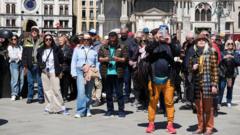As part of its ongoing efforts to manage tourist flow, Venice is implementing a new fee structure aimed at preserving the city's cultural integrity and alleviating congestion on peak days.
**Venice Increases Tourist Entry Fees Amid Overtourism Battles**

**Venice Increases Tourist Entry Fees Amid Overtourism Battles**
In a bid to combat overtourism, Venice will double the number of days requiring tourists to pay an entry fee starting in 2025.
In a significant move to tackle overtourism, Venice plans to double its entry fee requirement for tourists from 29 to 54 days in 2025. The mayor, Luigi Brugnaro, announced that the city seeks to better manage the influx of visitors while ensuring that Venice is treated with the respect it deserves. After a "successful" trial of the fee structure last year, tourists who book in advance will be charged €5 for access on select days in Spring, with prices climbing to €10 for last-minute bookings.
This initiative will see charges imposed on Fridays through Sundays and public holidays from April 18 to July 27, 2025. Travelers over the age of 14 will need to pay through their smartphones and present a QR code upon request in key arrival areas, such as the train station, while those without proof of payment might face fines.
Exemptions will remain in place for hotel guests, local residents, university students, and visitors with family ties in the city. The city's response to the overtourism crisis has been praised, with councillor Simone Venturini highlighting Venice’s proactive approach. Local authorities reported a successful collection of entrance fees during the initial trial period, garnering approximately €2.4 million within just over two months, an amount they had initially anticipated over the course of three months.
However, the operation costs tied to the ticketing platform and promotional campaigns, reported to be around €3 million, suggest a need for further analysis regarding the scheme's financial viability. Critics, including opposition councillor Giovanni Andrea Martini, argue that the increased fees may not effectively distribute visitor flow and could detract from Venice’s charm, essentially turning it into a mere museum. Concerns persist as UNESCO has warned of the city's precarious status due to climate threats and tourism pressures, underscoring the urgency for sustainable solutions. Given the recent ban on large cruise ships after safety incidents and environmental concerns, Venice continues to grapple with the delicate balance of tourism and preservation.
This initiative will see charges imposed on Fridays through Sundays and public holidays from April 18 to July 27, 2025. Travelers over the age of 14 will need to pay through their smartphones and present a QR code upon request in key arrival areas, such as the train station, while those without proof of payment might face fines.
Exemptions will remain in place for hotel guests, local residents, university students, and visitors with family ties in the city. The city's response to the overtourism crisis has been praised, with councillor Simone Venturini highlighting Venice’s proactive approach. Local authorities reported a successful collection of entrance fees during the initial trial period, garnering approximately €2.4 million within just over two months, an amount they had initially anticipated over the course of three months.
However, the operation costs tied to the ticketing platform and promotional campaigns, reported to be around €3 million, suggest a need for further analysis regarding the scheme's financial viability. Critics, including opposition councillor Giovanni Andrea Martini, argue that the increased fees may not effectively distribute visitor flow and could detract from Venice’s charm, essentially turning it into a mere museum. Concerns persist as UNESCO has warned of the city's precarious status due to climate threats and tourism pressures, underscoring the urgency for sustainable solutions. Given the recent ban on large cruise ships after safety incidents and environmental concerns, Venice continues to grapple with the delicate balance of tourism and preservation.





















